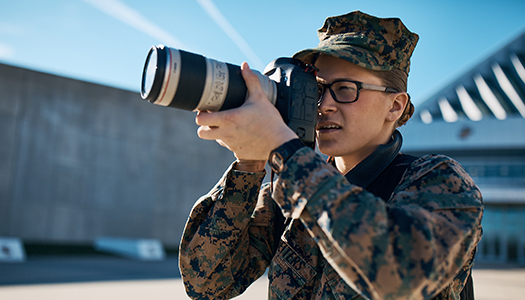- Home
- Career Overview
-
Looking
-
Applying
- College Overview
-
Planning
-
Applying
-
Paying
-
Attending
- Military Overview
-
Joining
-
Serving
INDUSTRY:
Military communications jobs may see service members specialize in reporting, sound and video production, media relations and other creative roles.
There are 10 military careers in this industry
Explore stories from service members who have Arts, Audio/Video Technology & Communications careers
Arts and media directors are experts in graphic arts, digital photography, layout design, cinematography, and video production. They create a variety of visual communications products for various outlets, and supervise personnel involved in the creation of such materials.
Audiovisual and broadcast technicians plan, supervise, and coordinate the operation, maintenance, deployment, and management of systems, facilities, and personnel engaged in visual information operations. They play a high-level, but hands on, role in the production process.
Communications equipment repairers install, sustain, troubleshoot, and repair standard voice/data/video networks, cable distribution systems, communication security equipment (COMSEC), and cryptographic devices in fixed and deployed environments to ensure the ability to communicate and the Military’s continued success.
Graphic designers and desktop publishers use their creativity in the areas of production, maintenance, and coordination related to visual products and presentations. They use computer software or manually develop the overall layout and production design for various media such as advertisements, brochures, magazines, and reports.
Instrumentalists play one or more musical instruments in recital, in accompaniment, and as members of an orchestra, band, or other musical group. For instrumentalists, knowledge of musical conducting, rehearsal techniques, transpositions, and the ability to read printed music are mandatory. Instrumentalists may lead or direct other musicians.
Music composers and arrangers write and transcribe musical scores. They adapt music into customized musical arrangements and create original music for various musical ensembles. Knowledge of music theory, transpositions, capabilities of instruments, and the ability to arrange and compose music using industry standard software are mandatory. Music composers may lead or direct other musicians.
Military music directors direct and conduct instrumental and vocal performances by musical groups, such as orchestras, bands, or choirs. They ensure that musicians play with one coherent sound, balancing the melody, timing, rhythm, and volume. They usually work in offices and band halls but may work outdoors when conducting or practicing for parades.
Musicians in the Military perform for members of their own service branch and to engage the public. They play indoors in theaters, concert halls, and at dances, and outdoors at parades and open-air concerts. They perform many types of music, including marches, classical, jazz, and popular music. They also travel regularly and may lead or direct other musicians. There are many kinds of musicians, including instrumentalists, vocalists, and music composers and arrangers.
Military photographers and videographers have an important job in communicating and recording military activity. Photographers photograph people, landscapes, merchandise, and other subjects, using digital or film cameras and other equipment. Videographers use a variety of electronic media to record videos for television, internet, and film.
Vocalists read, sing, and memorize vocal parts for public performances. They perform in a variety of musical concert units, such as chorus, popular musical ensemble, jazz band, country band, quartet, and soloist. Vocalists boost morale, entertain, and assist with military ceremonies and may lead or direct other musicians. They are part of a group of talented musicians who support the Military’s mission around the world.